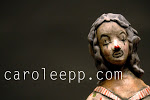Full Circle: Joan Bruneau
My pots function as decorative objects
activated through use. Containment, delivery or presentation of food or
flowers completes their aesthetic potential. Sensual forms and sumptuous
surfaces inspire interaction with the viewer.
The
confluence of function, symbolism, technique and composition drive the
evolution of new forms, patterns and glazes. My pottery forms and
surfaces take cues from various cultures and periods in ceramics
history, natural phenomena and ornament. Shape and surface compositions
may evoke a season, landscape, architectural detail, or flower. The
variables of form and surface possibilities offer the potential to layer
meanings and influences.
Using Lantz earthenware native to
Nova Scotia, my wheel thrown and constructed pottery is decorated with
slip, sgraffito, under glazes and polychrome food safe glazes. The forms
are wheel thrown and assembled using “Cut and Paste” technique
characterized by gestural throwing lines, dynamic volumes and structural
seams. The surfaces are treated with brushed white slip, sgraffito,
under glazes and polychrome food-safe glazes.
Various glaze
palettes employed in Full Circle are intended to enhance different
foods, from fresh spring and summer salads to hearty, savoury dishes.
The flower bricks are also intended to compliment flowers and foliage
available through the seasons but also presentation of seasonal foods
and flowers, corresponding to a specific shape, glaze palette and
function. The Four Season Flower Brick Set, celebrates the natural
beauty and diversity of Eastern Canadian seasons while alluding to the
four seasons, a universal theme associated with the cycles of life,
death and regeneration.The Dutch developed the flower brick form in the
17thc to display highly prized tulips. In this case, individual flower
bricks containing seasonal flowers and/or indigenous foliage may be
displayed separately or unified in a circular configuration as a set.
The exhibition will also investigate the disruption of natural cycles by
human intervention through a series of pieces addressing the
globalization of food sources.
This venue offers the potential
to attract a broader public audience associated with the farmer’s
market who may not associate ceramics or fine craft with broader issues
such as the 100 mile diet vs. globalization of food sources. The
exhibition in this venue presents the opportunity to bolster the
relevance of fine craft and contemporary ceramics within a broader
social context.
Joan Bruneau has been a full time studio potter in Lunenburg, Nova Scotia and Regular Part-Time Faculty in the Ceramics Department at NSCAD University since 1995. She earned her BFA from NSCAD in 1988, and MFA from the University of Minnesota in 1993.
Joan was Assistant Professor at Emily Carr University, Vancouver 1998-2001 and has taught in the Distance Ceramics Diploma Programs at Red Deer College, the Australia National University and Glasgow School of Art .
She teaches workshops and lectures across Canada and the US. Her work is exhibited throughout North America and is in public collections including the AGNS, Canada, Sykes Gallery, USA and Jingdezhen Ceramics Institute, China.
Joan was the 2009 recipient of the Established Artist Recognition Award from the Nova Scotia Arts and Culture Partnership and the 2005 recipient of the Winifred Shantz Award which funded her residency at La Meridiana Ceramics Residency in Italy in 2005.
Or read more here: http://thechronicleherald.ca/artslife/201217-ns-potter-comes-full-circle
Mary E. Black Gallery
1061 Marginal Road, Suite 140, Halifax, NS B3H 4P6
(902) 492-2522
Hours: Tue – Fri 9-5 | Sat & Sun 11-4 | closed Mon & holidays
[email protected]
www.craft-design.ns.ca/gallery.html
Cathy Terepocki Studio Sale
Well in case you haven’t
heard the sad news, Saskatoon is losing the ever lovely Cathy Terepocki.
So if you want one last chance to see and grab one, or two or three
pieces of her amazing work for yourself then you’d better not miss her
studio sale. One day only this Sunday from 1pm to 4pm.
Of course you can still
find her work on Broadway at the Better Good. But this will be a great
opportunity to pick up some new work or old stock and seconds in both
dishes and jewllery.
221 31st Street. W. Saskatoon (back alley studio entrance)
Full Circle: An exhibition by Joan Bruneau
Ying-Yueh Chuang: In Search of Paradise
a collector of things, it is the small elements that most people
overlook that inspire me most, the pieces that are thrown out or read as
undesirable. “
The North-West Ceramics Foundation is pleased to announce Ying-Yueh Chuang as their featured speaker at a free public lecture Thursday, November 29, at 7:30 pm.
The lecture will be held in Room 245 in the North Building of Emily
Carr University of Art + Design (1399 Johnston Street, Granville Island,
Vancouver). All are welcome and encouraged to attend.
and raised in Taiwan, Ying-Yueh Chuang came to Canada in the 1990s,
attending and receiving a diploma from Langara College in 1997 and a BFA
from Emily Carr Institute in 1999. She received her MFA in Ceramics
from NSCAD University, after which she participated as an Artist-in
Residence at Harbourfront Centre in Toronto, where she continues to live
and work, from 2001 to 2004. Chuang received the Winifred Shantz Award
for Ceramics in 2006 as well as a number of Provincial and Canada
Council awards for her work. Her work is included in numerous public
collections such as the Art Gallery of Nova Scotia, the Canada Council
Art Bank and the WOCEK Icheon World Ceramic Centre in Korea, and it has
been featured in Art in America, Ceramics Monthly, Ceramic Review and Ceramics Art & Perception.
She has participated in exhibitions in Canada, the United States,
Hungary, Taiwan, Korea, China and Australia. In May of 2012, her work
was shown in a two-person travelling exhibition with Eliza Au, Variations on Symmetry, at the Evergreen Art Gallery in Coquitlam.
finds inspiration in things as simple as a grocery store, where the
myriad forms and textures of vegetables suggest possibilities for
exploration. Observing plants, she notices how structures and
environments integrate and repeat to make complex wholes, which have the
potential to expand exponentially. Much of her work incorporates
complex symmetries, which she observes in nature, using hundreds of
brightly glazed components assembled on site. Often organized
geometrically, her compositions suggest scientific specimens, with
figures pinned to a board rather than left living and free. Underlying
the candy-coloured surfaces is an examination of order and freedom, both
personal and social, which reflects her experience in both the
populated, fairly homogenous culture of Taiwan, where rigid expectations
govern family and social relations, and the sparsely populated and
heterogeneous Canadian environment. Chuang values both, and her
installations grow out of mediating the tensions between the two
cultures.





















